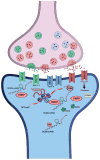Non-coding RNA transcripts: sensors of neuronal stress, modulators of synaptic plasticity, and agents of change in the onset of Alzheimer's disease
- PMID: 19699259
- PMCID: PMC2767472
- DOI: 10.1016/j.neulet.2009.08.032
Non-coding RNA transcripts: sensors of neuronal stress, modulators of synaptic plasticity, and agents of change in the onset of Alzheimer's disease
Abstract
Non-protein-coding RNAs (ncRNAs) play critical roles on many levels of cellular information processing and pervasive expression of ncRNAs in the nervous system could help explain brain complexity. NcRNAs are enriched in the central nervous system and are associated with specific neuroanatomical regions. Additionally, several recent publications have revealed an important role for deregulation of ncRNAs in various human neuropathologies, such as Alzheimer's disease, Parkinson's disease and Fragile X mental retardation. Herein, we summarize reports on functional ncRNA molecules involved in cellular stress response, particularly related to Alzheimer's disease. We conclude that ncRNAs have a prominent role in maintaining precise physiological levels of gene products directly implicated in Alzheimer's disease pathology.
Figures


Similar articles
-
The neurobiology of non-coding RNAs and Alzheimer's disease pathogenesis: Pathways, mechanisms and translational opportunities.Ageing Res Rev. 2021 Nov;71:101425. doi: 10.1016/j.arr.2021.101425. Epub 2021 Aug 9. Ageing Res Rev. 2021. PMID: 34384901 Review.
-
Noncoding RNAs in Alzheimer's Disease: Overview of Functional and Therapeutic Significance.Curr Top Med Chem. 2024;24(19):1615-1634. doi: 10.2174/0115680266293212240405042540. Curr Top Med Chem. 2024. PMID: 38616763 Review.
-
Linking deregulation of non-coding RNA to the core pathophysiology of Alzheimer's disease: An integrative review.Prog Neurobiol. 2017 Sep;156:1-68. doi: 10.1016/j.pneurobio.2017.03.004. Epub 2017 Mar 18. Prog Neurobiol. 2017. PMID: 28322921 Review.
-
Non-Coding RNAs in Neurological and Neuropsychiatric Disorders: Unraveling the Hidden Players in Disease Pathogenesis.Cells. 2024 Jun 19;13(12):1063. doi: 10.3390/cells13121063. Cells. 2024. PMID: 38920691 Free PMC article. Review.
-
Generation of a neuro-specific microarray reveals novel differentially expressed noncoding RNAs in mouse models for neurodegenerative diseases.RNA. 2014 Dec;20(12):1929-43. doi: 10.1261/rna.047225.114. Epub 2014 Oct 24. RNA. 2014. PMID: 25344396 Free PMC article.
Cited by
-
A novel collection of snRNA-like promoters with tissue-specific transcription properties.Int J Mol Sci. 2012;13(9):11323-11332. doi: 10.3390/ijms130911323. Epub 2012 Sep 11. Int J Mol Sci. 2012. PMID: 23109855 Free PMC article.
-
Experimental RNomics and genomic comparative analysis reveal a large group of species-specific small non-message RNAs in the silkworm Bombyx mori.Nucleic Acids Res. 2011 May;39(9):3792-805. doi: 10.1093/nar/gkq1317. Epub 2011 Jan 11. Nucleic Acids Res. 2011. PMID: 21227919 Free PMC article.
-
The majority of total nuclear-encoded non-ribosomal RNA in a human cell is 'dark matter' un-annotated RNA.BMC Biol. 2010 Dec 21;8:149. doi: 10.1186/1741-7007-8-149. BMC Biol. 2010. PMID: 21176148 Free PMC article.
-
Studying a Drug-like, RNA-Focused Small Molecule Library Identifies Compounds That Inhibit RNA Toxicity in Myotonic Dystrophy.ACS Chem Biol. 2015 Dec 18;10(12):2706-15. doi: 10.1021/acschembio.5b00430. Epub 2015 Sep 28. ACS Chem Biol. 2015. PMID: 26414664 Free PMC article.
-
Functional genomics of human brain development and implications for autism spectrum disorders.Transl Psychiatry. 2015 Oct 27;5(10):e665. doi: 10.1038/tp.2015.153. Transl Psychiatry. 2015. PMID: 26506051 Free PMC article. Review.
References
-
- St Laurent G, 3rd, Wahlestedt C. Noncoding RNAs: couplers of analog and digital information in nervous system function? Trends Neurosci. 2007;30:612–21. - PubMed
-
- Gagen MJ, Mattick JS. Accelerating, hyperaccelerating, and decelerating networks. Phys Rev E Stat Nonlin Soft Matter Phys. 2005;72:016123. - PubMed
-
- Taft RJ, Pheasant M, Mattick JS. The relationship between non-protein-coding DNA and eukaryotic complexity. Bioessays. 2007;29:288–99. - PubMed
-
- Mattick JS. A new paradigm for developmental biology. J Exp Biol. 2007;210:1526–47. - PubMed
-
- Mattick JS. RNA regulation: a new genetics? Nat Rev Genet. 2004;5:316–23. - PubMed
Publication types
MeSH terms
Substances
Grants and funding
LinkOut - more resources
Full Text Sources
Medical

